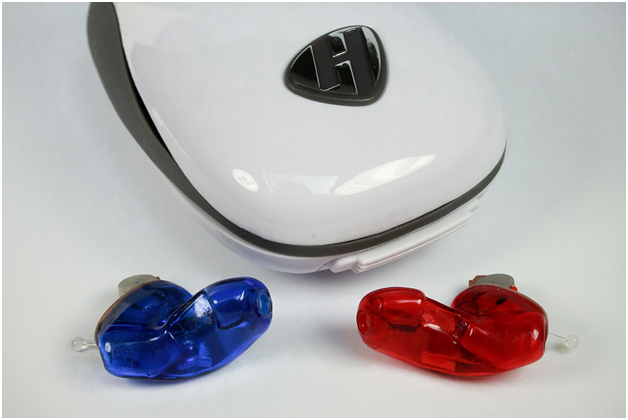Should You Go for Rechargeable Hearing Aid Batteries?
Dec 3rd 2021

In the world of hearing aids, there are disposable batteries and there are rechargeable batteries. Deciding whether you should go for rechargeable hearing aid batteries or not is easier when you know the pros and the cons. And that’s what this article is all about.
To clear up any confusion, rechargeable batteries come in two kinds. One is sealed inside the hearing aid with no battery door for access. This is the kind your mobiles, tablets, cameras, and laptops have.
The other is the removable kind that you can put inside the power system you have total access to. We will also discuss this below.
Pros and Cons
Rechargeable hearing aids are not a new invention. However, because rechargeable batteries, in recent years, have greatly improved in power and capacity, rechargeable hearing aids are fast becoming mainstream now.
But just because your friends have them doesn’t mean you should get one for yourself too. Here are some advantages and disadvantages of rechargeables as well as disposables to help you make the right choice for you.
Pros and Cons of Hearing Aids with Rechargeable Batteries
There are three types of rechargeable batteries in the market today. They are:
●Nickel Metal Hydride (NI-MH)
●Lithium-Ion (Li-ion)
●Silver Zinc (Ag-Nz)
Whatever type your hearing aid has, rechargeable batteries mean you don’t have to suffer the inconvenience of buying all the time. You’ll probably be able to save money as well, though given the low cost of disposable batteries, the amount you’ll save won’t be much and will probably just be offset against the cost of repair or replacement of rechargeable hearing aid batteries.
Rechargeable hearing aids with Lithium-Ion batteries have an integrated power system, which means there are no battery doors and no small batteries to handle. The battery is already inside the hearing aid that you can charge by simply docking them on its charger.
Charging can be quite convenient. You leave it to charge overnight and it will be ready for another day’s use by the time you wake up the next morning.
With rechargeable hearing aids, you won’t have to deal with changing small batteries and all the frustrations that come with it.
If you’re environmentally conscious, you’d also be happy to know that you won't be contributing to the pollution. You’ll only have to change your battery every four to five years.
But there are also disadvantages. For instance, if you forgot to charge, you’ll have to go without your hearing aid for several hours until you can charge it again.
Also, if you happen to run out of battery in the middle of the day, whether you’re inside or outside the house, you’ll be walking around without your hearing aid and straining to hear what everyone around you is talking about.
Carrying the charger or the dock is also more inconvenient than carrying small spare batteries that you can just pop in your device anytime and anywhere.
Pros and Cons of Hearing Aids with Disposable Batteries
Perhaps the biggest advantage of disposable hearing aid batteries is that you can change the battery anytime your hearing aid runs out.
The disposable button batteries are small and portable too, so even when you’re not at home and you’re outside, you can carry spares with you and never worry about not being able to join in conversations or catching what the lady in the supermarket is saying. Big stuff.
Your hearing aid device options are also not limited since, currently, there are more hearing aids with disposable batteries available in the market than rechargeable ones, though that may soon change.
Button batteries are cheap and readily available most anywhere, so even if you’re always changing your batteries, there is no fear of either you running out of money or stores running out of stock.
But that’s also the biggest downside. On average, people using disposable batteries for their hearing aids consume about a hundred per year. That is a lot of buttons and a lot of trash. And you know, a lot of trash is bad for the environment.
Another disadvantage is that aging hands will have a problem handling small batteries and putting them inside small spaces of small devices. The only consolation here is that they will only have to do it every 3 to 7 days (for small batteries) and up to 20 days (for bigger batteries). That’s the average lifespan of disposable batteries.
If you want the convenience of both the disposable and the rechargeable kind, getting a hearing aid with battery doors and access to the power system may be best for you.
Rechargeable Hearing Aid Batteries
Nickel Metal Hydride and Silver Zinc are removable and rechargeable batteries. The upside to rechargeable hearing aids with access to battery is that you don’t have to take out the battery to replace it, which is good for those who have lost their hand dexterity.
You can also leave it to charge overnight and use it the following day. And what’s great is that if you forgot to charge it or you run out of battery while you’re using it, you can simply put in a spare and you’re good to go.
You still have to fiddle with the batteries when this happens but it’s such a small price to pay for having a hearing aid at all times and the times that matter most.
If you have questions about hearing aid batteries and accessories, or would like to find hearing aids batteries for your unique needs, get in touch with us at sales@localbattery.com.


